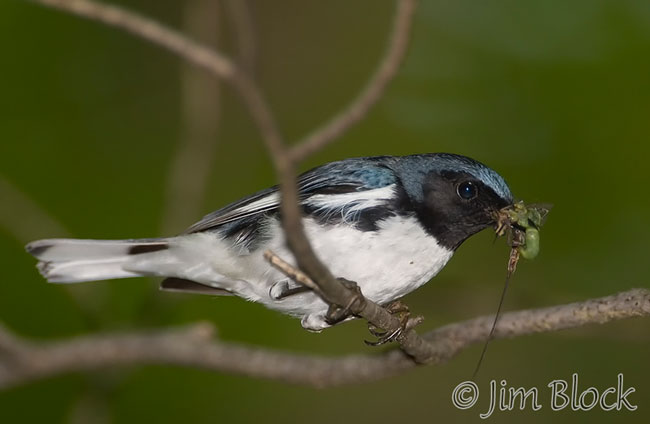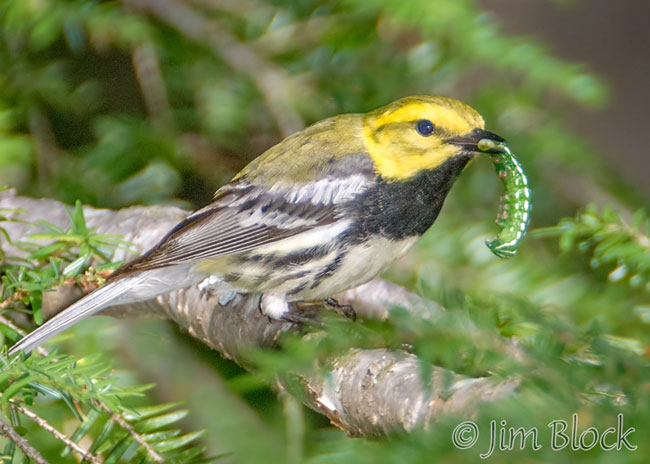This is an expanded and updated version of an article I wrote two years ago for another web site.
Warbler photography is very challenging – that’s what makes it was so rewarding when you capture a decent photo. Photographing warblers is hard work and requires a lot of patience, but they are around – all of the warblers discussed here are commonly found in New England.

Two Common Yellow Warblers
Perhaps the most widespread warbler and easiest to find is the Common Yellowthroat. Look in wet brushy or marshy habitats and weedy fields. Common Yellowthroats respond very well to “pishing” – saying “pish pish pish” to try to get a curious bird to come and investigate.
Another common and widespread species in the Northeast that favors wet deciduous thickets is one of my favorite warblers, the Yellow Warbler. When I photograph birds I hope to capture them singing as I did in the two photos shown here. Occasionally photographing with a fairly slow shutter speed hoping to get a pleasing motion blur as with the Yellow Warbler at the beginning of this piece can be a rewarding technique.


Near The Ground and High Above in The Forest

A forest warbler that is much more often heard than seen is the beautiful Ovenbird. They are ground nesters and like to forage in the leaf litter deep in the forest. Their domed nests somewhat resemble an old fashion outdoor oven and hence their name. Ovenbirds have a loud insistent song “teacher teacher TEACHER” that is quite unmistakable. I still remember my first photograph of an Ovenbird – I thought I had captured a thrush.
We move from the forest floor and search for a Pine Warbler high up in the pines where they feed on insects, although occasionally they will forage on the ground. Their song is a fast trill lasting a couple of seconds and is sometimes confused with the song of a Chipping Sparrow or Dark-eyed Junko.

Record Both Genders
It’s always rewarding to capture a photo of both the male and female of a warbler species, especially those that exhibit a strong sexual dimorphism. That’s a fancy way of saying that the males and females look very different. American Redstarts are extremely active insect eaters that never seem to stand still. Occasionally one is lucky enough to photograph them between quick darts after insects which they sometimes catch in the air. Look for American Redstarts in open wooded habitats dominated by deciduous trees.


Beyond a Portrait
It is especially rewarding to capture birds carrying something in their bill whether it is nest material or an insect to feed their young. Here is a brief slideshow of a female Chestnut-sided Warbler with nest material, a Black-throated Blue Warbler with an impressive insect, a Black-throated Green Warbler with a caterpillar, and a Canada Warbler with a moth.
Not For Those Who Have Trouble Hearing High Notes

A pair of warblers with thin high-pitched songs is the Black-and-white Warbler and the Blackburnian Warbler. The Black-and-white’s song sounds a little bit like a squeaky wheel. It forages along tree branches and trunks much like a nuthatch probing the bark for insects. The Black-and-white is one of our earliest arriving migrating warblers – a sure sign of spring. However, normally the Pine Warbler will beat it here, often arriving in early April.
The Blackburnian is somewhat similarly patterned but has brilliant orange breeding plumage. It is a bird of the coniferous forests. It can be a hard species to photograph because it normally forages high up in conifers. But in spring, as in the photo here, and in the fall migration, it can be found closer to the ground.
Equipment Options

So how does one go about photographing warblers if $5-10,000 or more of loose change is not available to buy one of those huge lenses? In recent years many birders have taken to digiscoping, which is basically marrying a birding scope with a small, often point-and-shoot, digital camera. This can work extremely well for certain species but, because warblers tend to be constantly on the move, it is a very challenging method to use to photograph them.
In the last few years, a number of relatively moderately priced digital cameras with extremely long lenses have reached the marketplace including the Canon SX60, Nikon P900, Fujifilm S1, Pentax XG-1, Sony HX300, and Samsung WB2200. These all have lenses that reach at least 1200 mm (full frame equivalent) with the Nikon reaching 2000 mm. Although I am a Nikon guy and have never used any of these, if I was buying one of these I would look only at the Canon or Fujifilm. Why? These are the only two that capture raw images.
All of these cameras have sensors that are considerably smaller than in a DSLR. This means that they are more susceptible to noise. The way to keep noise in control is to shoot at the lowest possible ISO. Unfortunately, if one is using a very long lens, 1200 mm or more as in these cameras, and trying to shoot handheld, it almost forces one to increase the ISO. The real solution to this is a sturdy tripod with a wired remote to trigger the camera. Of course, if you are trying to capture a warbler that is constantly in motion, a tripod might get in the way of following the bird. That’s one thing I love about photography. There are always compromises to be made and getting the picture often involves the best use of available tools and techniques while knowing which things can be compromised.
Those who would like to use their DSLRs but can’t afford the cost or weight of a Canon or Nikon 500mm f/4 or 200-400mm f/4, there are some interesting choices in the 150-600mm range from Sigma and Tamron that have Nikon or Canon mounts. And Nikon has released a relatively affordable 200-500mm f/5.6 lens that is certainly worth serious consideration by those with Nikon bodies. The Nikon 200-500 has excellent optics and superb vibration reduction. It is a heavy lens, but it can be used hand held when necessary. Married with the long-awaited D500 this should be a killer combination for action photography, and warblers are certainly in action most of the time.
If you are looking for a real photographic challenge try warblers. You will often spend the whole day and come back with nothing. But you can rejoice in the fact that you were outdoors all day.




